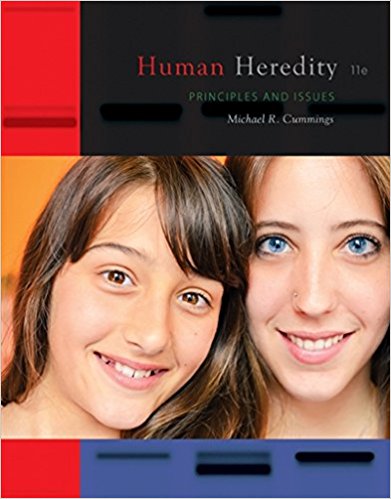Description
Test Bank Human Heredity Principles and Issues 11th Edition
Table of Contents
1. A Perspective on Human Genetics.
2. Cells and Cell Division.
3. Transmission of Genes from Generation to Generation.
4. Pedigree Analysis in Human Genetics.
5. The Inheritance of Complex Traits.
6. Cytogenetics: Karyotypes and Chromosome Aberrations.
7. Development and Sex Determination.
8. The Structure, Replication, and Chromosomal Organization of DNA.
9. Gene Expression and Gene Regulation.
10. From Proteins to Phenotypes.
11. Genome Alterations: Mutation and Epigenetics.
12. Genes and Cancer.
13. An Introduction to Genetic Technology.
14. Biotechnology and Society.
15. Genomes and Genomics.
16. Reproductive Technology, Genetic Testing, and Gene Therapy.
17. Genes and the Immune System.
18. Genetics of Behavior.
19. Population Genetics and Human Evolution.
Appendix.
Glossary.
Index.
Chapter 01 – A Perspective on Human Genetics
1. Normal white blood cells (called B cells) and cancerous B cells that cause leukemia both carry a unique surface protein called CD-19.
a. True
b. False
ANSWER: True
DIFFICULTY: Bloom’s: Remember
REFERENCES: 1-1 Genetics and Translational Medicine
LEARNING OBJECTIVES: HUHE.CUMM.16.1-1-1 – Explain the connection between genetic research and clinical medicine as it relates to cancer treatment.
2. Genetic modification of immune cells has not been shown to be an effective leukemia treatment.
a. True
b. False
ANSWER: False
DIFFICULTY: Bloom’s: Remember
REFERENCES: 1-1 Genetics and Translational Medicine
LEARNING OBJECTIVES: HUHE.CUMM.16.1-1-1 – Explain the connection between genetic research and clinical medicine as it relates to cancer treatment.
3. The human genome carries approximately 20,000 genes.
a. True
b. False
ANSWER: True
DIFFICULTY: Bloom’s: Remember
REFERENCES: 1-7 What Impact Is Genomics Having?
LEARNING OBJECTIVES: HUHE.CUMM.16.1-7-1 – Describe genome sequencing and illustrate various methods of use in the treatment of disease, genetic testing, and plant and animal modification.
4. In the years after the completion of the human genome project, genome sequencing revealed a surprisingly little amount of variation in the sequence and arrangement of nucleotides in humans.
a. True
b. False
ANSWER: False
DIFFICULTY: Bloom’s: Understand
REFERENCES: 1-7 What Impact Is Genomics Having?
LEARNING OBJECTIVES: HUHE.CUMM.16.1-7-1 – Describe genome sequencing and illustrate various methods of use in the treatment of disease, genetic testing, and plant and animal modification.
Chapter 01 – A Perspective on Human Genetics
5. In some societies, the birth of a deformed child is regarded as a sign of impending war or famine.
a. True
b. False
ANSWER: True
DIFFICULTY: Bloom’s: Remember
REFERENCES: 1-3 What Are Genes and How Do They Work? (Genetic Disorders in Culture and Art)
LEARNING OBJECTIVES: HUHE.CUMM.16.1-3-2 – Describe the role of genes in the production of proteins.
6. Genes are precisely copied during the process of DNA replication and never undergo any change.
a. True
b. False
ANSWER: False
DIFFICULTY: Bloom’s: Understand
REFERENCES: 1-3 What Are Genes and How Do They Work?
LEARNING OBJECTIVES: HUHE.CUMM.16.1-3-1 – Identify basic gene components and diagram the structure of a DNA molecule.
7. The U.S. has stayed ahead of the issues surrounding genetic technology by implementing ground-breaking public policy and laws.
a. True
b. False
ANSWER: False
DIFFICULTY: Bloom’s: Understand
REFERENCES: 1-2 Genetics Is the Key to Biology
LEARNING OBJECTIVES: HUHE.CUMM.16.1-2-1 – Define the term genetics and summarize its role in our understanding of all of biology.
8. The separation of genes during the formation of the sperm and egg and the reunion of genes at fertilization is explained by the behavior of chromosomes in a form of cell division called meiosis.
a. True
b. False
ANSWER: True
DIFFICULTY: Bloom’s: Remember
REFERENCES: 1-4 How Are Genes Transmitted from Parents to Offspring?
LEARNING OBJECTIVES: HUHE.CUMM.16.1-4-2 – Explain how Mendel’s research with pea plants has increased our understanding of how specific traits are passed from parent to offspring by genes.
9. Genetic discoveries made in one organism cannot necessarily be applied to other species.
a. True
b. False
ANSWER: False
DIFFICULTY: Bloom’s: Understand
REFERENCES: 1-5 How Do Scientists Study Genes?
LEARNING OBJECTIVES: HUHE.CUMM.16.1-5-1 – Compare and contrast the different methods scientists use to study genetics.





Be the first to review “Test Bank Human Heredity Principles and Issues 11th Edition”